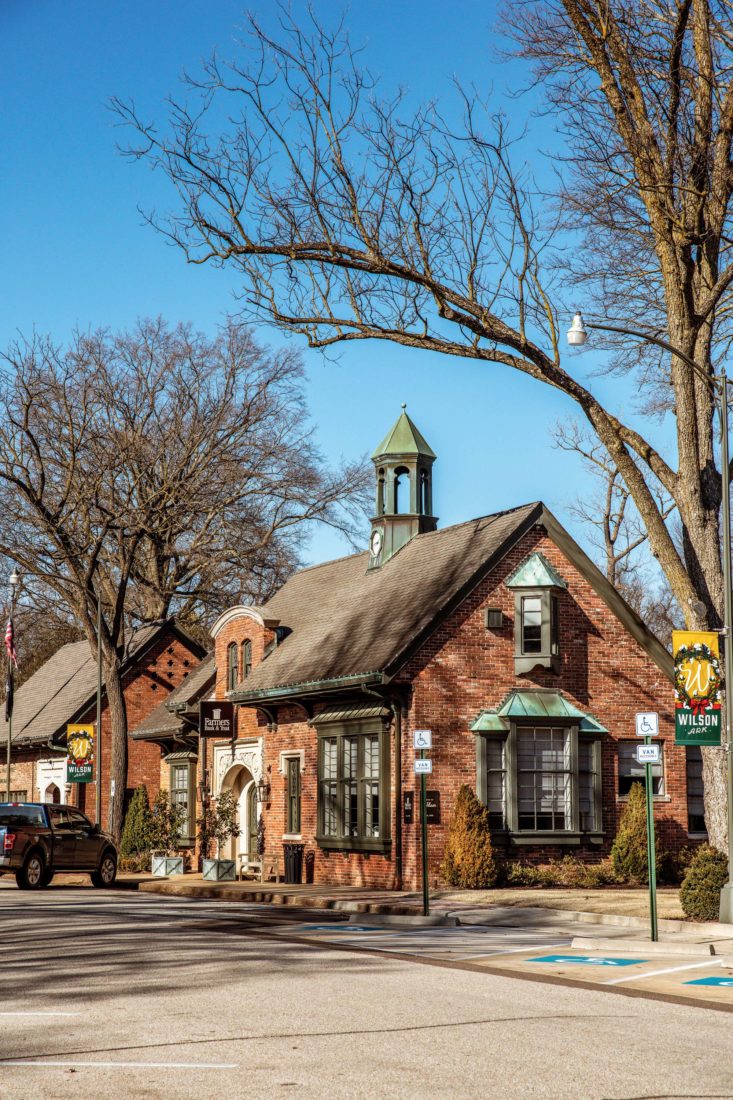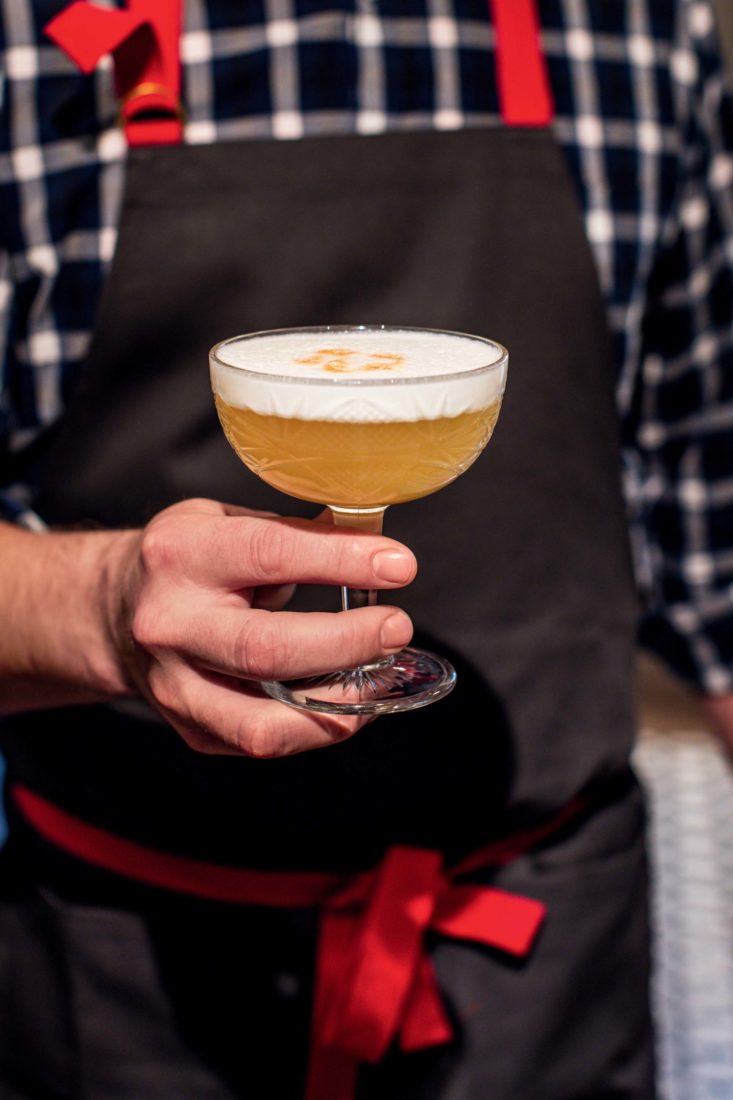WEEKENDS
The Staying Power of Small Southern Towns
How three communities in Arkansas, Mississippi, and Georgia are rewriting their story lines

Photo: From left: Lauren Carnes; Sarah Bell (2)
The courthouse in Madison, Georgia; buttermilk pie at Wilson Cafe in Wilson, Arkansas; a gas station near Dockery Farms in Cleveland, Mississippi.
Wilson, Arkansas
Sports a New Scene
By Nic Brown
There was a time when the tiny Delta town of Wilson, Arkansas, was booming so hard that it was ginning more cotton than almost anywhere else in the South, all of its storefronts were being built to resemble an English Tudor village, and the hundreds of employees working its fertile soil were paid in currency printed by Lee Wilson & Co., which created the town itself in 1886. Then the Depression hit, the cotton industry crumbled, and by the turn of the new millennium, the town had become a shell of its earlier self. “The winds, if they blew from the east,” says John Faulkner, Wilson’s former town manager, “would blow the glass out of the windows in the old boardinghouse on the square, and they would fall onto the street.” Just about all that was left open for business was the pharmacy, a bank, and the post office.

Photo: Sarah Bell
A water tower in Wilson, Arkansas.
Like many a Delta community, Wilson had almost faded away, before the arrival of Gaylon Lawrence Jr., chairman of the Lawrence Group, whose nationwide holdings include stakes in vineyards and citrus groves. Lawrence purchased Wilson and the sixty-two square miles of land surrounding it in 2010. And while he acquired the land for its farming potential, Lawrence developed an unlikely plan for Wilson itself: to remake the decaying Delta town, then population 912, into a center of art, culture, and education.
He brought in Faulkner to oversee those efforts, which started with improving phone reception (“That was on day three,” Faulkner says, as if recounting a sort of Delta Genesis), establishing free Wi-Fi, and repainting buildings on the square. Then, in hopes of finding someone to reopen Wilson’s only restaurant, Faulkner started cold-calling his favorite Memphis spots. “I was trying to steal their best chefs,” he confesses.

Photo: Sarah Bell
Downtown Wilson.
He found a pair of takers in chefs Joe Cartwright, who arrived from Memphis’s Elegant Farmer, and Shari’ Haley, from Interim restaurant, and their Wilson Cafe has since become a culinary oasis. Anchoring the square in an immaculately restored Tudorstyle building, the café serves upscale diner fare, much of it sourced from nearby Whitton Farms. Holly Williams, Hank Williams’s granddaughter, joined them on the square in 2017, opening an outpost of her modern general store, White’s Mercantile, in a former gas station and stocking the shelves with Southern-made goods—scrimshaw knives from Mollyjogger and Moonshine cologne from EastWest Bottlers. Last year, the outdoor clothing brand Tom Beckbe launched its flagship around the corner.

Photo: Sarah Bell
Sporting pursuits reign at Tom Beckbe.
“There are places that cast a shadow much bigger than their geographical footprint, and Wilson has become one of those places,” says Radcliff Menge, Tom Beckbe’s founder. “To our customers, the Delta is the center of the sporting world.”
To that end, Wilson boasts worthy options, including Pecan Point, a 6,400-acre Mississippi River island designated as part of the Wetlands Reserve Program, teeming with deer and duck, and as of last year, the Bar W Shooting Preserve. A joint venture with renowned Oxford, Mississippi–based Wildrose Kennels, Bar W offers 180 acres of quail and pheasant hunting. Wilson might be small, but its size is an asset, says Tom Smith, Bar W’s owner. “From the square to where we hunt,” he says,“it’s…maybe eight minutes away?”

Photo: Sarah Bell
Wilson Cafe co-owner Shari’ Haley greets guests; a warm welcome in White’s Mercantile.
Cultural offerings have also flourished. The Delta School, a Montessori meets project-based learning initiative, occupies the Wilson family’s restored Wildwood Mansion, for which the Alabama-born architect Bobby McAlpine designed additional classroom buildings. The new Hampson Archeological Museum State Park opened in 2018, a showplace for Native American artifacts. Renovation of the town’s historic theater is nearing completion, and once open it will house the on-going Wilson Music Series, which has already brought in the likes of John Oates and Maggie Rose. A sixteen-room boutique hotel is set to open this year.
Wilson’s land has always held possibility, but these days the town square is buzzing with life again too. “The Delta’s got a great reputation for grit,” Menge says. “Now Wilson is its polished-up diamond.”
Madison, Georgia
Protects Its Historic Charms
By Mike Grudowski
“This is, like, the signature building in Madison, the signature home,” says Christine McCauley Watts, executive director of the Madison-Morgan Conservancy. In Madison, Georgia, a jewel of a town about sixty miles east of Atlanta, that’s no small boast. The house she’s showing off, though, a once-proud 1883 Victorian, is hardly a showpiece at the moment: Flaps of peeling paint dangle from its lofty ceilings. Ancient wallpaper is darkened by soot from a fire that ravaged the five-thousand-square-foot home back in 2001, the last time anyone lived there. Birds nest in its chimneys.
But a look beneath the dust and neglect reveals astonishing bones, primed for an epic rebirth. It’s thought that the home’s builders took aesthetic cues from “House Beautiful”–themed lectures Oscar Wilde gave around the South in 1882, and remarkably intact flourishes are everywhere: mantelpieces of slate or carved cherry; pocket doors some twelve feet high; frescoed and stenciled ceilings; a copper sink in the kitchen’s blackened wreckage. The nonprofit that Watts oversees bought the house in 2018, rescuing it from the Georgia Trust for Historic Preservation’s “Places in Peril” list, then resold it last year to a young Atlanta couple who have hired a platoon of restoration experts. That’s the Madison version of happily ever after.

Photo: Lauren Carnes
A stenciled ceiling survives inside the fire-damaged Foster-Thomason-Miller House in Madison.
This budding preservation triumph is striking, but not at all unique in Madison, which is drawing a new generation of residents smitten with its back-in-the-day beauty. With a population that hovers around four thousand, it’s a gold mine for lovers of architecture and Southern history that thrived in the King Cotton economy. Dozens upon dozens of vintage structures—more than fifty antebellum houses among them—all seem to come with a story. That hulking 1895 Romanesque Revival brick cultural center on South Main Street, with the arched windows and Gothic-looking bell tower? Oliver Hardy attended first grade there. The stately house on Old Post Road with Greek Revival columns and a pecan grove? It belonged to Joshua Hill, a Georgia congressman who opposed secession and who, some speculate, may have influenced William Tecumseh Sherman’s troops to refrain from incinerating Madison on their 1864 March to the Sea. (“Too pretty to burn” is the oft-repeated shorthand for why Sherman spared the town, though that’s probably oversimplifying things.) The Rose Cottage, an unassuming one-story in the Folk Victorian style that’s open to visitors, was built in 1891 by Adeline Rose, a widow born into slavery who scraped out a living taking in boarders’ laundry for fifty cents a load. From an Italianate mansion with boxwood parterres to the Beaux-Arts redbrick Morgan County Courthouse to Craftsman bungalows, Madison’s historic district is a walk-in picture book of nineteenth- and early-twentieth-century American architecture.

Photo: Lauren Carnes
A home built in 1850 on Main Street.
Not surprisingly, a slow but steady trickle of newcomers keep falling hard for the town: second-home buyers and retirees from places like Atlanta and Miami seduced by magnolia-shaded neighborhoods and free parking; UGA football fans who pass through en route to home games up in Athens and eventually circle back for good. “We get two or three new residents out of every home tour,” says Monica Callahan, director of Madison’s planning department. “There are a lot of people who have chosen to be here purposefully.” The place has at least three well-supported garden clubs, and an endowment-funded “tree grant” program keeps things leafy. Volunteers pick up city-provided cleaning kits to scrub lichens off grave markers at the old cemetery. Historic preservation, says Ken Kocher, Madison’s preservation planner (and Callahan’s husband), “is absolutely woven into the fabric of the town.”

Photo: Lauren Carnes
An old-fashioned at Town 220 in Madison.
Madison’s history isn’t something suspended in amber, though; the town feels lived in, as comfortable as an old leather chair. Historic spaces find new purpose. At Town 220, a cavernous dining room on the site where a cotton gin once rumbled, residents gather for dry-aged steaks and voluminous cocktails. A onetime horse livery on West Washington Street has become a bustling pizza joint. The old Central of Georgia railroad depot is getting a face-lift, primping for a new role of some sort, perhaps as a nonprofit incubator.

Photo: Lauren Carnes
GG0220_Smalltowns_13
The front sitting area at the James Madison Inn, with paintings of the historic downtown by Suzita George
“We just knew there was somewhere better to live,” says Jane Royal. She and her husband, Everett, arrived twenty-four years ago from Atlanta and have since built the elegant James Madison Inn and a spacious antiques emporium, Madison Markets. “I wanted to find a nice, quaint, historic town. Madison was it. I just knew it when I came.”
Cleveland, Mississippi
Sings Again
By Caroline Sanders

Photo: Sarah Bell
A lemon sour at Cleveland’s Delta Meat Market.
It used to be the classic small-town story: “Growing up here, we spent our whole lives figuring out how to get out,” Cole Ellis says of Cleveland, Mississippi, a Delta hamlet twenty miles east of the Mississippi River. Now Ellis has become something of a prodigal son. The proprietor of Delta Meat Market and a James Beard Award semifinalist, Ellis has been on the forefront of Cleveland’s revival since moving back to his hometown in 2013 and opening the restaurant, known for its Berkshire pork chops, hanger steaks, and kielbasa and grits. Last year he relocated it across the street to the lobby of the new Cotton House hotel, where he also runs the chic rooftop spot Bar Fontaine. “People my age who left town are now coming back to dig roots,” he says. “We’re making this flatland the place to be.”

Photo: Sarah Bell
Cole Ellis at his Delta Meat Market.
The halfway point on Highway 61 between Memphis and Vicksburg, Cleveland came to life when the Louisville, New Orleans & Texas Railway barreled through in 1884 and helped transform it into a commercial center amid the Delta’s cane thickets and alluvial floodplains turned cotton fields. In the 1920s, Delta State University set up shop. But as the cotton industry waned, Cleveland struggled.
The culture that grew out of that soil, though, has helped spark the town’s reawakening. Dockery Farms, former sharecropping land ten minutes east of downtown, was home to famed bluesman Charley Patton, who lured a who’s who of musicians to play for the thousands of people residing and working there and nearby. So many blues greats dropped in that B. B. King declared Dockery the birthplace of the genre. Now a stop along the Mississippi Blues Trail, the site draws pilgrims to see a restored cotton gin, the mule watering trough where sharecroppers got baptized, and the commissary porch where musicians offered another kind of redemption. Films illustrating the essential connection between cotton farming and the blues project onto barn walls, and modern stars such as Tedeschi Trucks Band and Rosanne Cash have been known to make appearances.

Photo: Sarah Bell
Dockery Farms, where the blues play on.
Because of the town’s history as a musical Eden, in 2016, the Grammy Museum in Los Angeles established its second location in Cleveland, displaying instruments used by King and Bruno Mars, and currently an exhibition celebrating women in country music.
“Cleveland to me is a land of opportunity,” says native musician and businessman Justin Huerta. Along with Hey Joe’s burger joint and Mosquito Burrito, Huerta founded Keep Cleveland Boring, a nonprofit intended to do just the opposite of its tongue-in-cheek name. It throws pub crawls and restaurant weeks, and has lured in Nashville and Austin musicians. In April, the organization’s Anotherfest brings bands to venues across town, before the Pour Mississippi Beer and Music Festival washes downtown in suds in May.

Photo: Sarah Bell
Smoked chicken, beans, and collard greens at the Senator’s Place.
“I wish all of the Delta was having the success Cleveland’s having,” says Mississippi Transportation Commissioner Willie Simmons, who served as a state senator for twenty-seven years. He opened the Senator’s Place restaurant in town in 2003, satisfying constituents with platters of okra and tomatoes, collards, peach cobbler, and “the world’s best smoked chicken.” Down the street sits Country Platter Restaurant, with its bright blue facade and warm plates of fried chicken and purple hull peas. Formerly Lilley’s Soul Food Cafe, the spot hosted civil rights leaders during the 1950s and ’60s, including Martin Luther King Jr. and Medgar Evers, who met with local businessman and voting rights activist Amzie Moore. Moore’s house around the corner opened in 2016 as an interpretive museum.
Stroll downtown and you’ll pass a string of charming family-owned storefronts, including the gallery Studio 230, lined with Turkish-born artist Çetin Oğuz’s surreal abstract works and Mississippi painter Tommy Goodman’s haunting landscapes.
“Everyone thinks the Delta is dying, but Cleveland shows its viability,” says Emily Jones, the archivist at Delta State. “These young people coming into town and putting their hard-earned money into the economy remind me of the early settlers: finding the goodness here, determined to make this place work.”







